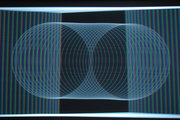DLP Projectors
Digital Light Processing (DLP) is a technology used in projectors and projection televisions. DLP was originally developed by Texas Instruments, and they remain the sole manufacturer of such technology, though many licensees market products based on their chipsets. more...
In DLP projectors, the image is created by microscopically small mirrors laid out in a matrix on a semiconductor chip, known as a Digital Micromirror Device (DMD). Each mirror represents one pixel in the projected image. The number of mirrors corresponds to the resolution of the projected image: 800×600, 1024×768, 1280×720, and 1920 x 1080 (HDTV) matrices are some common DMD sizes. These mirrors can be repositioned rapidly to reflect light either through the lens or on to a heatsink (called a light dump in Barco terminology).
The rapid repositioning of the mirrors (essentially switching between 'on' and 'off') allows the DMD to vary the intensity of the light being reflected out through the lens, creating shades of grey in addition to white (mirror in 'on' position), and black (mirror in 'off' position). There are two primary methods by which DLP projection systems create a color image, those utilized by single-chip DLP projectors, and those used by three-chip projectors.
Single-chip projectors
In a projector with a single DMD chip, colors are produced by placing a color wheel between the lamp and the DMD where it is reflected out through the optics. The color wheel is usually divided into four sectors: the primary colors: red, green, and blue, and an additional clear section to boost brightness. Since the clear sector reduces color saturation, in some models it may be effectively disabled, and in others it is omitted altogether.
The DMD chip is synchronized with the rotating motion of the color wheel so that the green component is displayed on the DMD when the green section of the color wheel is in front of the lamp. The same is true for the red and blue sections. The red, green, and blue images are thus displayed sequentially at a sufficiently high rate that the observer sees the composite "full color" image. In early models, this was one rotation per frame. Later models spin the wheel at two or three times the frame rate, and some also repeat the color pattern twice around the wheel, meaning the sequence may be repeated up to six times per frame.
The DLP "Rainbow Effect"
This visual artifact is best described as brief flashes of perceived red, blue, and green "shadows" observed most often when the projected content features bright/white objects on a mostly dark/black background (the scrolling end credits of many movies being a common example). Some people perceive these rainbow artifacts all of the time, while others say they only see them when they let their eyes pan across the image. Yet others do not notice the artifact at all. The effect is likely rooted in the concept of the flicker fusion threshold.
The image to the right shows how a white circle looks to a camera while panning horizontally, using a long exposure. The white light is visibly split into into its colored components. The rainbow effect occurs when this is visible to the naked eye. The multiple images of the circle represent the individual frames of video, and are unrelated to the rainbow effect.
Read more at Wikipedia.org



